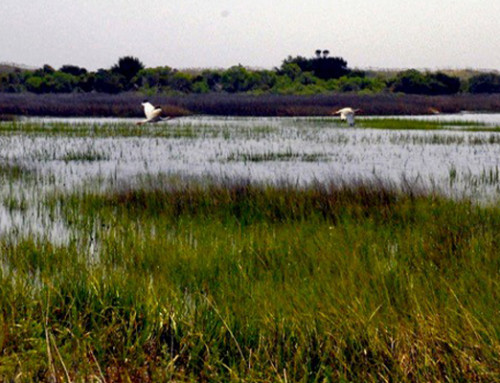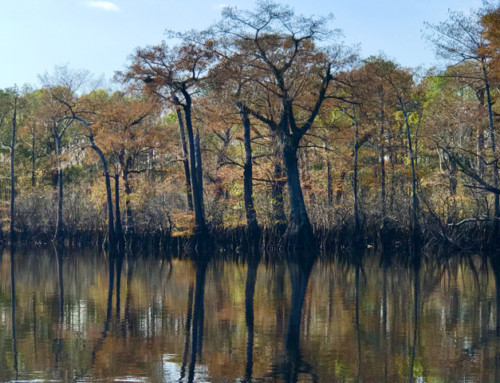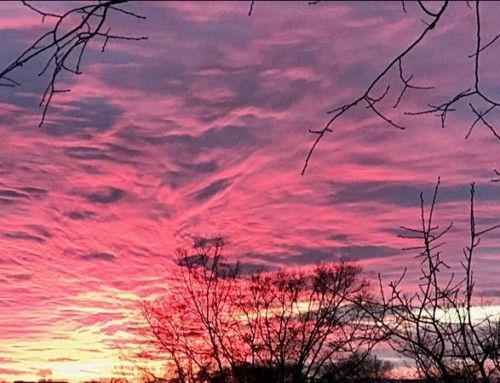A Photo Series from NC photographer and naturalist Tom Earnhardt
Looking Backward to Move Forward
For several years now much of my outdoor exercise has been in a small rowboat. I row on lakes, slow rivers, and coastal estuaries. I love calm water and a breezy chop, cool mornings and humid afternoons, a gentle rain and bright sun. I row on roughly the same number of days in January as in June. It dawned on me several years ago that one of the great advantages of a rowboat is that you have to look backward in order to move forward.
Now, I’m sure you’re wondering, what possible advantage or lessons can there be in looking backward from a 14-foot rowboat? While facing to the rear, I move the boat forward by pulling two 9-foot wooden oars through the water using my arms, back, and legs. The boat is slow (about 5 mph), and taking it on open water presents some challenges. From experience, I have learned what weather conditions I can tolerate and those I consider dangerous. Perhaps most important, I have learned to watch and follow the example of experienced captains with “time on the water.” In my small boat, I’m also reminded that by studying and understanding past practices and events in science, the environment, medicine, farming, politics, business, diplomacy, and in all other endeavors, we are equipped to make better decisions.
This is not an insight or concept original to me. The same idea—studying the past to understand the future—has been stated in a variety of ways. Perhaps my favorite variation is attributed to Winston Churchill: “The farther backward you look, the farther forward you can see.“
This is not a complicated or profound thought. Every day, consciously and unconsciously, we make decisions in our lives based on past events and the advice of those we trust. We rarely go back to restaurants where we had a bad meal, and we don’t return to hotels if we had a sleepless night. We often choose books or movies because we like the earlier work of the same writer. We go back to doctors, barbers, or Uber drivers who have earned our trust.
Most law schools use the “case law method” in which students study court decisions from years or decades past. Business and management schools use “case studies”—the story of a particular business—to give students problem-solving tools for the future. The farther back you look, the farther ahead you can see.
In my work, I have traveled the state with geologists to rock formations more than one billion years old near Blowing Rock and to the “young” limestone formations at Castle Hayne (near Wilmington). I have watched paleontologists from the North Carolina Museum of Natural Sciences in Raleigh as they have unearthed 220-million-year-old fossils from the Triassic Basin near the Research Triangle Park. I’ve been with coastal scientists and geologists to observe evidence of shorelines past, as sea levels have risen and fallen over many millennia.
With foresters and specialists in dendrochronology (experts in finding climate history in tree rings), my work has taken me to some of the oldest living trees in North Carolina. I have also been privileged to spend time in laboratories and in the field with biologists and ecologists whose job it is to determine why certain plants and animals are threatened, endangered, or extinct. Taken together, the work of women and men in the natural sciences tell us the story of where we’ve been, and where we are headed.
In the natural sciences mentioned above—geology, paleontology, dendrochronology, and biology—the most important thing that any scientist possesses is his/her credibility. Because of their study and experience they serve “guides” for rest of us in their complex disciplines. This is true whether they work for a university, museum, the private sector, or government. Throughout my professional life I have depended on scientists who are experts in their fields. Like the rest of us, they have hobbies and are involved in their communities, but while performing their work, they leave their politics, religion, and personal histories at the door.
For all of us, the coronavirus pandemic is frightening and alien to our experience. The loss of life, and livelihood, is unfathomable and unknown to our generation. Most of us have never worn a face mask around our neighbors, or avoided physical contact—handshakes, hugs, or dinners—with close friends. The majority of Americans have never experienced fear or uneasiness about sending their children to school. Now, for our families, friends, and the human species, we are urgently seeking answers for the days and months ahead.
For an old rowboat captain, these are new waters, and a different kind of storm. Like most of you, I have neither the personal experience nor the professional background to deal with a pandemic, but I know where to turn. I will trust to experts with “time on the water.” These are the women and men in the public health sciences whose lives have been dedicated to the understanding and control of disease. In my lifetime they have lead us through polio, HIV, Ebola, and myriad other threats. Some of them have names—Dr. Anthony Fauci in Washington and Dr. Mandy Cohen in Raleigh. Many work at extraordinary institutions like the School of Public Health at UNC Chapel Hill, the National Institutes of Health (NIH) in Maryland, and the Centers for Disease Control (CDC) in Atlanta. Others live and work in your community at your county “Department of Public Health.”
It is time for all North Carolinians and Americans to listen to their public health professionals, and to the mayors, state officials, and national leaders who bring scientists, and science, squarely into the decision making process. Our public health professionals and agencies have a proven track record of success in difficult times. In recent weeks we have watched as nations in other parts of the world have “flattened the curve” by following established public health practices. With discipline, patience, and guidance from scientists of our public health community, we can do the same.
We have the history, tools, and the right people to lead us. How do I know? I learned it in a rowboat: The farther backward you look, the farther forward you can see.
Choosing “captains with time on the water,”
Tom
In a rowboat, you face backward in order to move forward. Sometimes the water is calm and the view over the stern is beautiful (photo #1). I have also learned what weather conditions I can tolerate and those I consider dangerous (photo #2).


The ancient rock cliffs at Pilot Mountain reveal their age and origin to experienced geologists (photo #3). In Castle Hayne limestone you can still see shells and impressions of shells in calcite mud (photo #4).


The North Carolina coast is spectacular, but our barrier islands, as shown in this photo looking south from Hammocks Beach State Park (photo #5), are dynamic and moving westward.

At a number of places on our coast you can see ancient tree stumps, usually live oak, in the surf at very low tide. I took this photograph above Corolla in 2010 (photo #6). Several hundred years ago these were living trees on the backside of the of the dune line. With rising seas, Tar Heel barrier islands will move westward, sometimes leaving stumps in the surf.

Along the west bank of the Chowan River, near Colerain, NC, sand cliffs rising as high as 85 feet above the river, tell us much about the history of North Carolina’s coastal plain (photo #7).

From tree ring experts, dendrochronologists, we can learn much about the age of North Carolina’s trees and the weather events through which they’ve lived. There are living cypress trees on the Black River more than 2000 years old (photo #8). We know their ages because of “core samples” taken by scientists.

Longleaf pine trees in North Carolina often have rings that often show evidence of forest fires over the centuries. In our study of longleaf pine forests, we have learned that the longleaf, and the plants and animals around them, thrive when there are periodic forest fires (photo #9).

In the sciences and in life’s other endeavors, the farther back you look, the farther ahead you can see. Guides with experience can help us find a safe horizon (photo #10)

All photos in this series are by Tom Earnhardt. Narration by Tom Earnhardt except slight editorial corrections






